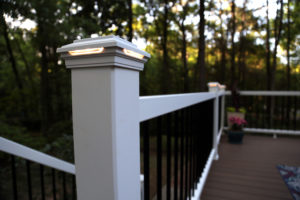Deck Safety Checklist
By Dave KileDeck collapse may seem uncommon, yet about 500 people a year are injured in such events. Often, a combination of shoddy workmanship, decaying wood, and too many people on the deck combine to create nightmare situations. The videos are terrifying.
To raise awareness of this danger, the North American Deck and Railing Association (NADRA) observes Deck Safety Month each May. In the United States, about half of all decks are not built to code, posing a real risk to homeowners and their guests.
What can you do to improve safety? Start with the following tips to evaluate your deck.
How Do You Inspect Safety on a Deck?
Here are some important areas to inspect while you’re evaluating deck safety:
- Rotten wood: The most significant danger for any wood deck is moisture and decay, especially at the ledger board, where the deck connects to the house. Often, collapses are due to rot or defective hardware attaching the deck to the house. If you see any soft or discolored wood, push on it with a screwdriver. If you can easily push ¼ to ½ inch into the lumber, beware. Look, too, for any small holes in the wood, which might indicate insect damage.

- Flashing: Because rot is such a danger, protecting the wood, especially the gap between the house and deck, is essential. Flashing and flashing tape provide a thin protective barrier, so your wood never gets wet and lasts longer.
- Rusted fasteners and hardware: In the past, builders preferred nails as the hardware of choice for deck connectors. However, after loose nails led to deck collapses, builders began using screws to secure the boards, support posts, beams, and joists. Use exterior screws and hangers that resist rusting and corrosion when exposed to the weather and won’t react to the chemicals (ACQ) in treated wood. For composite decking, use hidden fasteners, which are not visible from the board tops. As you inspect, be sure to replace any missing or rusted hardware.
- Railings: One of the most important parts of a deck safety inspection involves the handrail and balustrades. The International Residential Code (IRC) states that handrails be in place for any deck higher than 30 inches above the ground. Railings should measure at least 36 inches in height, and the space between individual balusters (the vertical posts in a railing) should be less than 4 inches to prevent children from slipping through the guardrails. The distance between the bottom of the railing and the top of the deck surface also should be no more than 4 inches.

- Stairs: Check the railings, the stringers (the risers on the sides of the stairs), and the tops of the stair boards to make sure there is no loose or rotted wood. If you have an open area behind the stair treads, it should be no more than 4 inches high. Railings should be no more than 4 inches apart.
- Grills and Fire Pits: Any heat element can damage the decking. Make sure you keep grills, fire pits, and chimineas off the deck boards, or use a heat-resistant pad. Follow all manufacturer’s instructions.
What do Deck Inspectors Look For?
Deck inspections cover a variety of construction issues, including making sure the right fasteners are used and that deck posts are properly installed. While no one wants to fail a deck inspection, the good news is that if you’ve uncovered an issue, you can now fix it. That’s the safest choice. Being ignorant of a failing deck can have dangerous consequences.
While anyone can DIY an inspection using the NADRA safety tips if you have an older deck or you find something concerning, be sure to contact a professional home inspector.
National Deck Safety Month
Why do we need Deck Safety Month? As with any other annual observation, it’s a chance to stop and remember to inspect your deck and practice regular maintenance. A deck stands in all kinds of weather, meaning it will be put to the test by the elements. Once a deck has endured a harsh winter, you don’t want to roll into summer without making sure everything is safe and sound.
What Should You Not do When Building a Deck?
When it comes to new deck building, here are a few important don’ts:
- 1 Don’t skip a building permit. A permit protects you, the homeowner, so be sure to call your local authority to find out what is needed. Follow all building codes.
- 1 Don’t forget to call 811. Before digging, always check for underground utilities.
- 1 Don’t pass on installing flashing tape over your joists, beams, and ledger board.
How Do You Prepare the Ground Under a Deck?
Post holes should be dug below the frost line to avoid movement due to frost heave. Because wood can quickly break down when exposed to moisture, anchor wood posts to concrete footings with piers rather than putting them into the ground. Once you have prepared the ground for a deck build, have an inspector come in to make sure the posts are properly installed.
 Decks can last for 25+ years if built to code and properly maintained. Clean it regularly and stain or seal it every couple of years. Especially remove all debris and mildew, which can trap moisture. Of course, if you have composite decking boards — which are virtually maintenance-free — you shouldn’t have to stain your boards. Just clean them.
Decks can last for 25+ years if built to code and properly maintained. Clean it regularly and stain or seal it every couple of years. Especially remove all debris and mildew, which can trap moisture. Of course, if you have composite decking boards — which are virtually maintenance-free — you shouldn’t have to stain your boards. Just clean them.
Check your deck this Deck Safety Month. Enjoy outdoor living and breathe a sigh of relief knowing your deck is safe for the summer season.
